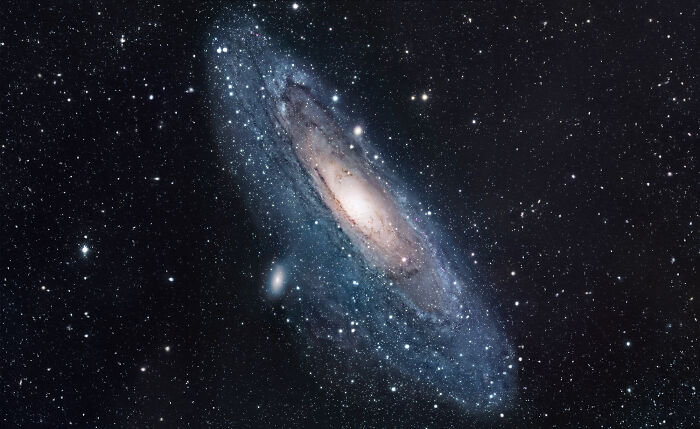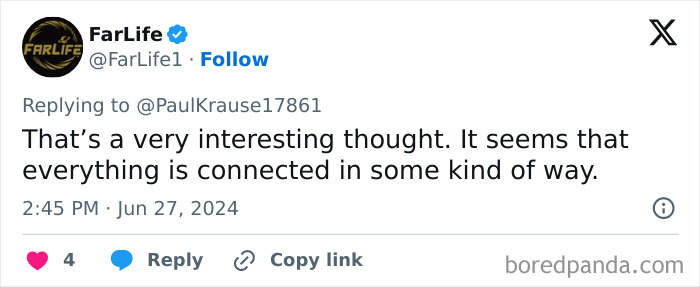
Scientists Share About The Possibility Of Existence Of Other Universes, People Are Intrigued
The concept of multiple universes goes back to the 6th century, when pre-Socratic Greek philosopher Anaximander suggested the idea of infinite worlds for the first time.
Yet multiverse ideas gained scientific weight only in the 1980s, together with the inflation theory, which not only explained why the cosmos is so flat and smooth, but also predicted an endless creation of new ‘bubble’ kinds of universes.
And now, it seems that scientists are finally closer than ever to finding the evidence that could prove the multiverse’s existence.
A hundred years on from Edwin Hubble’s proof that other galaxies are out there, we might soon find proof of the multiverse’s existence
Image credits: ESA Hubble
Image credits: ESA
Image credits: ESA Hubble
The most developed model of a multiverse known to date is cosmological inflation. The theory was first proposed by physicist Alan Guth in the 1980s, who suggested that after the Big Bang, around 13.8 billion years ago, the universe expanded exponentially quickly for a fraction of a second. This process could be compared to a huge microscope that magnified the temporary random change in the amount of energy in a point in space, corresponding to a scale less than 10-28cm, to cosmological distances by leaving marks in the cosmic microwave background and in the distribution of galaxies.
Inflation is also part of the current known model of the universe, called the Lambda Cold Dark Matter (LCDM), in which the shape of the universe’s trajectory reminds a funnel which is growing and spreading further out over time.
At the heart of this cosmological inflation there’s an idea of ‘bubbles’ – endless unique universes which were created when some parts of space-time expanded faster than others.
A Russian-American theoretical physicist, Andrei Dmitriyevich Linde, later on noticed that the exponentially rapid expansion of the universe could appear not only in the false vacuum, but also during a slow transition away from the false vacuum. Therefore, in 1983, he suggested another version of inflationary theory – chaotic inflation. The physicist in his study explained the inflation as a natural (and may be even inevitable) consequence of chaotic initial conditions in the early universe.
Yet in 2013, when the European Space Agency announced the map of the cosmic microwave background (CMB) made from the data collected by a satellite called Planck, the inflation theory faced some serious challenges.
While multiverse ideas gained scientific weight in the 1980s with the proposal of inflation, nowadays scientists are looking for alternative ideas
Image credits: ESA
Image credits: NASA
Image credits: NASA
Therefore, in recent years, many cosmologists have been searching for the alternatives that could finally reveal the story of our universe’s history. One of such could be the cyclic universe theory, which states that the universe forms itself again and again in cycles.
“What I didn’t like about inflation was that there are very few genuine predictions – you don’t get out much more than you put in. It just struck me that there has to be a better explanation,” said Neil Turok, a physicist at the University of Edinburgh, UK.
Scientists who proposed the cyclic model are suggesting that the Big Bang was not the beginning of time. They believe that there was another phase leading up to it, which has multiple cycles of contraction and expansion that repeat indefinitely.
“It allows us to go beyond the Big Bang, but without any kind of magical philosophical issues, because time has always existed in the past,” shared Stephon Alexander, a professor of physics at Brown University, and the co-inventor of an inflation model of the universe based on string theory.
As another concept that doesn’t invoke cosmic inflation, in 2018, physicist Neil Turok proposed a mirror universe – one that is stretching backwards in time from the Big Bang.
While the inflation theory states that the early universe exploded into an infinite number of different universes, known as the inflationary multiverse, the mirror universe theory is way more economical and predictable.
“It’s an approach that was born out of a certain sense of frustration with previous approaches. In my view, they had all become rather complicated and contrived, including my own approaches,” Turok explained.
“I think we could be on the verge of the next big revolution in theory. It will be inspired by the data, by the failure of traditional paradigms. It will change our view of the universe,” he added.
Turok and his team’s prediction is that our universe could have a twin in which time moves backwards.
Image credits: Physics
“We know that the early universe was dominated by hot radiation. This means that, if you rewind the clock from there, the size of the universe shrinks to zero in a very simple way. Mathematically, you can follow a straight line which cuts through the Big Bang. This allows us to extrapolate backwards to another ‘mirror image’ copy of our universe on the other side of the Big Bang,” the physicist shared the revolutionary idea.
“The two sides of the universe grow steadily in opposite directions away from the big bang, governed by the known laws of gravity and particle physics. The extreme simplicity of the large-scale universe, which is very smooth and flat, is a direct result of the simplicity of these laws,” he added.
Turok’s mirror universe theory not only suggests a simpler explanation of the universe’s history, but also aims to get some answers about dark matter.
“We realized our idea could solve the puzzle of dark matter, the mysterious substance that holds galaxies together, in terms of particles that we have not directly seen but already have strong evidence for,” shared Turok.
“These are called right-handed neutrinos. They have been invoked since the 1970s to explain the tiny masses of left-handed neutrinos, which have been observed. Whereas every other model of dark matter postulates a completely new particle, we don’t have to. That came as a huge surprise,” he added.
While the mirror universe theory goes further in explaining things inflation can’t, all the scientific predictions will be tested in large-scale galaxy surveys such as the Vera C. Rubin Observatory.
The largest LSST camera ever built for astrophysics, at 3200 megapixels, will soon help unlock the universe’s mysteries by taking detailed images of the southern hemisphere sky for 10 years, creating the most comprehensive time-lapse view of our universe we’ve ever seen.
“Getting the camera to the summit was the last major piece in the puzzle. With all Rubin’s components physically onsite, we’re on the home stretch towards transformative science with the LSST,” excitedly shared Victor Krabbendam, who’s a Project Manager for Rubin Observatory.
Rubin Observatory, with their 3200-megapixel LSST camera, the largest ever built, is on the way to finding evidence of the multiverse’s existence
Image credits: VERA C. RUBIN Observatory
Image credits: VERA C. RUBIN Observatory
Image credits: ESA Hubble
Modern physics, including quantum theory and cosmology, suggest several theories about how our universe may be just one of many. Until today, all of them have still lacked some proof or evidence, yet it seems that very soon, the situation is going to change.
Thanks to Vera C. Rubin Observatory and their largest digital camera ever constructed, we may find out we are living in an entire ocean of other universes.
People on the internet were overwhelmed with the news about the possibility of the multiverse’s existence
Image credits: FarLife1
Image credits: Tony93390137892
Image credits: FindLightInc
Image credits: SerinaColes4
Image credits: chantasia22
Image credits: AlgalonObserver
Image credits: BeanPoleUnite
Image credits: BbveaBianca
Image credits: DavidEk47672468
The universe isn't stranger than we imagine - it's stranger than we can imagine - Arthur C Clarke.
The universe isn't stranger than we imagine - it's stranger than we can imagine - Arthur C Clarke.

 Dark Mode
Dark Mode 

 No fees, cancel anytime
No fees, cancel anytime 




































































42
14